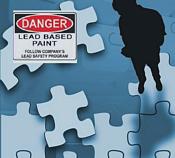Question: Does the RRP rule require people working on a renovation to wear respirators, Tyvek(R) suits or other personal protective equipment (PPE)?
Most renovation contractors have little knowledge or experience with OSHA requirements. OSHA requirements concentrate on the occupational safety of the worker. There are many OSHA requirements that contractors should already be following if they use employees or sub contractors on their job sites. Because lead can create serious health risks for employees and workers, employers would be wise to become familiar with the OSHA requirements related to the work they perform under the EPA RRP rule.
The required containment methods and work practices have changed the way work gets done in the field. Even if working within OSHA requirements in the past, new activities and methods used on RRP related projects most likely trigger personal protection considerations under OSHA regulations.
Unfortunately, while creating the EPA RRP rule, the EPA did not include reference to any specific OSHA requirements. Therefore, renovators need to know and understand both the RRP rule as well as any related OSHA requirements in order to protect workers and avoid potential penalties from OSHA and or EPA. To learn more about the related OSHA requirements, renovators can refer to the OSHA Lead in Construction Standards.
 In the new MA RRP rules, still yet to be enforced as of this posting, many of the OSHA requirements related to RRP work have been included in the regulations. When I met with employees from the MA Department of Occupational Safety to discuss the proposed rule, they were very helpful in clarifying the reasons for adding these consideration. So, although the EPA and OSHA may not have collaborated when the EPA RRP rule was created, MA renovation contractors will have the advantage of knowing what OSHA requirements they will need to consider depending on the work they do as well as the methods they use to do the work. Reading the MA RRP rule would help renovators working under the EPA RRP rule identify many of the related OSHA considerations.
In the new MA RRP rules, still yet to be enforced as of this posting, many of the OSHA requirements related to RRP work have been included in the regulations. When I met with employees from the MA Department of Occupational Safety to discuss the proposed rule, they were very helpful in clarifying the reasons for adding these consideration. So, although the EPA and OSHA may not have collaborated when the EPA RRP rule was created, MA renovation contractors will have the advantage of knowing what OSHA requirements they will need to consider depending on the work they do as well as the methods they use to do the work. Reading the MA RRP rule would help renovators working under the EPA RRP rule identify many of the related OSHA considerations.
Here is EPA's response to the question at the beginning of this post:
"EPA would like to clarify the requirements for personal protective equipment. The Occupational Safety and Health Administration (OSHA) has requirements for personal protective equipment, EPA does not. For many years, EPA has recommended the use of personal protective equipment as a way to protect workers and to help ensure that leaded dust and debris does not leave renovation or abatement work sites. EPA recommends that renovators make use of the minimum respiratory protection recommended by the National Institute of Occupational Safety and Health (NIOSH) for environments where lead is present, but respiratory protection is not required by the EPA regulations. In addition, disposable clothing, if removed and disposed of before the workers leave the work site, can provide additional protection for workers' families by ensuring that no leaded dust or debris is carried home on worker clothing. However, EPA does not require this and allows renovators to use other methods to ensure that dust and debris does not leave the work area, including the HEPA vacuuming of clothing, tools, and other items before they leave the work area."

 Looking for accurate information about the EPA RRP rule?
Looking for accurate information about the EPA RRP rule? 



